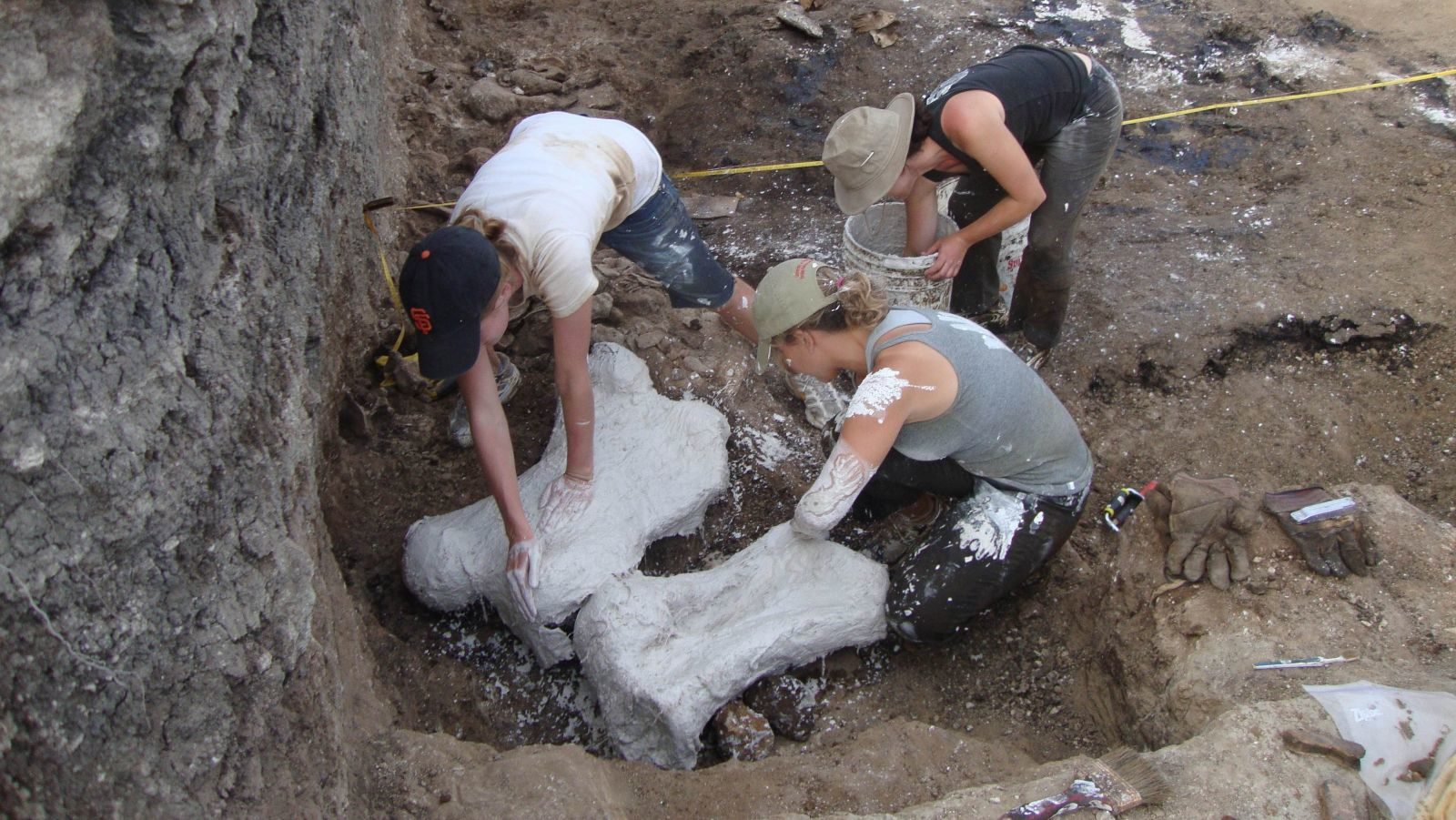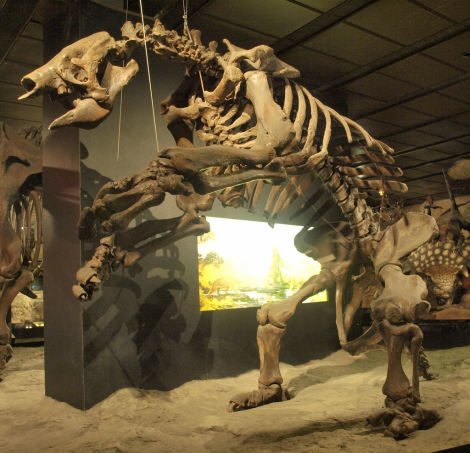
Some 20,000 years later, the fossils of these enormous creatures would be found by chance. Many of the bones were disarticulated and had the type of gouges paleontologists would interpret as traces of trampling by other creatures after they had died. Something catastrophic caused 22 giant ground sloths — many the size of modern elephants — to perish at the same time and in the same place. In a paper published this month, researchers describe what they think led to the sloths' demise.
The remains of these giant ground sloths — as well as those of an ancient horse, deer, pampathere, and gomphothere — were found in the Santa Elena Peninsula in Ecuador. Fifteen of the giant ground sloths were adults; the rest were subadults and juveniles, a couple of them so tiny that they might have been newborns or even fetuses.
Humans have a long history of exploring and exploiting natural tar seeps in the Santa Elena Peninsula, and these are hardly the first fossils to be found in the asphaltic sediments. Tar seeps in the area enabled indigenous people to seal their boats; in recent history, oil could be found so close to the surface that people could dig by hand to extract it. This much digging into the ground has revealed the numerous fossil treasures preserved within. But, after clearing the edge of a hill, it was a local oil company in 2003 that discovered what would be referred to as "Tanque Loma" — the site of this mass-death assemblage and more. "Loma" means hill, and "tanque" refers to the oil containers that stand atop that hill.
Although the fossils were preserved in asphalt, the authors do not believe this was a true tar pit. When most of us think of Ice Age tar pits, our minds go directly to one of the most famous: the La Brea Tar Pits in California, a site we immediately associate with animals mired in tar with no escape. Yet, even though these giant ground sloth fossils were found in asphalt, the authors find no evidence that they died in it.
"For years, everyone has thought of the classic scenario at the La Brea Tar Pits, where a large herbivore would get stuck in asphalt, then a bunch of carnivores would be attracted to the trapped animal and get stuck themselves, then birds would get stuck, insects would get stuck, etc.," explained the study's lead author, assistant curator and excavation site director at La Brea Tar Pits Emily Lindsey, in an email to Gizmodo.
Comment: The scenario above is highly questionable considering how rare it is in our own time to see so many different animals behaving so stupidly.
"Nothing got stuck at Tanque Loma! The animals died in an aquatic setting like many other fossil sites, and the bones just fortuitously got preserved by seeping asphalt. It blew my mind when I first realized that."
Everything within the sediment preserving the fossils indicates that it was once a marshy environment. Paradoxically, apart from some shells, nothing even remotely aquatic has been found. There are no ancient fish fossils, no fossil crocodiles, no fossil turtles. And herein lies another very important window into what happened: Why would these animals have died in a watery environment absent so many of the creatures one would expect to find there?
What the researchers did find in abundance were fossil plant remnants. Ancient twigs, leaves, and thorns, all uniformly small, and — particularly important — all equal to or smaller than the distance between the ridges (the 'interlophs') of giant ground sloth teeth. What this suggests is that these 22 giant ground sloths were completely surrounded by their own feces or gut contents.
To help reconstruct what may have happened to these giant ground sloths, the authors looked to one of today's megafauna: the hippopotamus. In the 1970s, hippos at the Selous Game Reserve in Tanzania were observed over 18 months. Approximately 140 hippos gathered around a watering hole to drink from and wallow in the cool water at the beginning of the dry season. As time went on, the water began to grow smaller, and the amount of feces grew larger. By the end of the season, hippo corpses littered the edges of the much tinier watering hole, their feces both in and around what little water remained. The water had been contaminated, and the hippos had died from that contamination. By the end of the dry season, only 40 of the 140 hippos survived.
Comment: That's one theory.
This scenario seems to make the most sense for understanding what happened to the giant ground sloths of Tanque Loma, and it would certainly help explain the lack of fossil species one would find in a healthy water environment.
"There is nothing anywhere in the world today that is even kind of like a giant ground sloth. They're unique, and they're completely gone."
The variety of ages present in the Tanque Loma giant ground sloths and the fact that the fossils seem to have been preserved in-situ rather than carried there by ancient river flow offer an important clue about their behavior: They congregated together. They were social animals.
"Tanque Loma presents a rare accumulation of fossils that provides highly relevant data," José Luis Román-Carrión, a paleontologist at Escuela Politécnica Nacional who was not involved in the research, wrote in an email to Gizmodo. "Now we know that Eremotherium lived in groups and that it had parental behavior... We also have this type of evidence from another giant ground sloth, Oreomylodon wegneri, from the [capital city of Ecuador] Quito's valley."
Sloths today differ immensely from the giant ground sloths that once roamed South America. Contemporary sloths are arboreal, known for their slow, measured movements, and typically the size of a koala bear. Giant ground sloths, by contrast, could reach several tons. The species discovered at Tanque Loma is Eremotherium laurillardi, among the largest of the giant ground sloths, often compared to the size of an elephant. In fact, their size might have rivaled that of the ancient elephantid Notiomastodon platensis, a gomphothere whose fossils have also been found at Tanque Loma.
Like today's sloths, Eremotherium might have had a long tongue and the ability to extend its head, the better to reach leafy vegetation above. It may have also had a strong sense of smell, similar to its living relatives, thanks to large nasal cavities. Scientists have suggested that this might have helped Eremotherium determine palatable food sources. Unlike today's sloths, however, these giants could walk upright on two feet, although it appears that they tended to walk on all fours.
"[A] lot of the extinct Ice Age animals in the Americas have some living corollary somewhere on Earth today — horses, lions, wolves, elephants," said Lindsey. "But there is nothing anywhere in the world today that is even kind of like a giant ground sloth. They're unique, and they're completely gone."
"The biggest assumption I find people make about extinct sloths is that they moved as slowly as the modern sloths," wrote paleontologist Robert McAfee, who has done extensive research on extinct sloths, in an email to Gizmodo. "Extinct sloths likely moved as quickly as other larger xenarthrans (e.g. giant armadillo (Priodontes), giant and lesser anteaters (Myrmecophaga and Tamandua)), which, if you've had the opportunity to watch them, is pretty good pace!"
Erick Lopez Reyes, co-author of the new study and archaeologist at the Universidad Estatal Península de Santa Elena, is responsible for prompting his university to build the Museo Paleontologico Megaterio, where the Tanque Loma fossils are now housed. He and his U.S. counterparts are trying to persuade the Ecuadorian government to protect the larger area around Tanque Loma, called the "Arroyo Seco."
Wrote Román-Carrión, "The Santa Elena Peninsula is known as a locality where very important fossils have been found for South American and Ecuadorian paleontology. Tanque Loma is a very interesting place to study, and there is still so much to discover."
"There is definitely more of the fossil deposit left to excavate at Tanque Loma," agreed Lindsey. "We really don't know how far it extends yet! And there's a lot of material that we have excavated that hasn't been fully prepared and curated yet. There are many more studies that are waiting to be done with this remarkable assemblage, like looking at how these giant sloths grew (since we have such a range of sizes and ages), types of pathologies, and more radiocarbon dating of the deposit. But one of the most intriguing aspects of the site for me are the layers of microfauna-rich sediments a meter or so above the asphaltic megafauna deposit; these contain thousands of bones of small birds, lizards, snakes, and rodents that have real potential to tell a story of past environmental change in this region."
Jeanne Timmons (@mostlymammoths) is a freelance writer based in New Hampshire who blogs about paleontology and archaeology at mostlymammoths.wordpress.com.




Comment: There is another theory that, even if it may not explain the demise of the sloths investigated above, it may explain the sudden and near total extinction of our planet's megafauna; see Pierre Lescaudron's Volcanoes, Earthquakes And The 3,600 Year Comet Cycle for details.